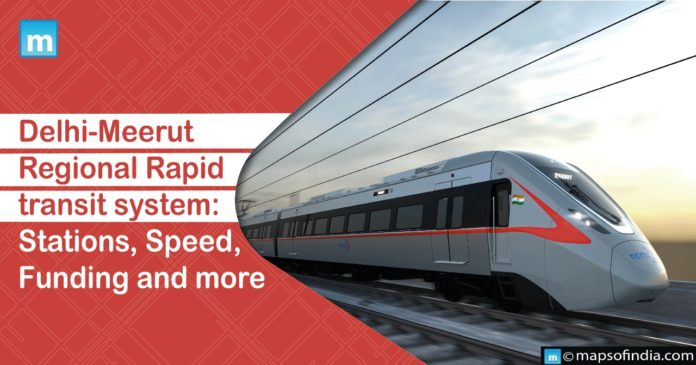Travelling has always been a cause of concern when it comes to travelling through public transport. Due to the long travel time, it becomes challenging to undertake journeys to faraway places. Catering to this problem, a task force was created in 2005 whose Chairman was the Secretary of the Ministry of Urban Development.
It was tasked with developing a multi-modal transit system for Delhi NCR. This system is also a part of the Integrated Transport Plan for National Capital Region 2032. Under this plan, India’s first rapid rail is being developed.
Let us know more about the Delhi – Meerut Regional Rapid Transit System in detail:
What is the Regional Rapid Transit System?
The Regional Rapid Transit System (RRTS), an initiative by the National Capital Region Transport Corporation (NCRTC), provides a new public transportation service that connects the national capital with cities like Ghaziabad, Muradnagar, Modinagar, and Meerut.
It will also provide us with a less time-consuming and comfortable commuting experience. Moreover, more people will be able to travel longer distances simultaneously due to its high capacity. In simpler terms, RRTS can be a more efficient and modern alternative to Indian Railways that covers long distances but halts at only a few stations.
Production of Rapid Trains
The RRTS trains are part of the Make in India initiative. All these trains equipped with the latest technologies and facilities will be manufactured at Alstom’s factory in Savli, Gujarat. The design of these trains was prepared in Hyderabad.
Stations on the Delhi-Meerut RRTS corridor
There are 25 stations on the Delhi-Meerut Regional Rapid Transit System Corridor. They can be classified into three broad categories: Elevated stations, Underground stations, and Depot stations. Here is the list of all of them:
| Delhi-Meerut RRTS Stations | |||
| Elevated | Underground | Depot | |
| Jangpura | Meerut South | Anand Vihar | Duhai Depot |
| Sarai Kale Khan | Partapur | Meerut Central | Modipuram Depot |
| New Ashok Naga | Rithani | Bhaisali | |
| Sahibabad | Shatabdi Nagar | Begumpul | |
| Ghaziabad | Bramhapuri | ||
| Guldhar | M E S Colony | ||
| Duhai | Daurli Metro | ||
| Muradnagar | Meerut North | ||
| Modi Nagar South | Modipuram | ||
| Modi Nagar North | |||
Features of the Delhi – Meerut Regional Rapid Transit System
Following are the features of the RRTS:
- The Delhi-Meerut RRTS corridor is 82.15 Km long. Out of which, 70 Km of the corridor is elevated and 12 Km underground.
- It will cover the distance from Delhi to Meerut in 55 minutes.
- Two maintenance depots are created at Duhai and Modipuram.
- The total cost of completion of this project is ₹30,274 crore.
- Different investors do the funding for RRTS. Around $1 Billion is invested by ADB, and $500 Million are invested by NDB and AIIB each. Apart from them, the central government is investing 20%, the Delhi government 3.22%, and the Uttar Pradesh government is investing 16.68%.
- A total of 40 trainsets containing 210 coaches will be manufactured. Off lately, the first train set has already been delivered.
- These trains are well equipped with 2×2 cushioned seats, premium and standard coaches, overhead luggage racks, wifi, charging sockets, infotainment systems, and other modern facilities.
- The ticket prices and ticketing system that RRTS will adopt are still in the planning process.
- A Memorandum of Understanding is signed with Solar Energy Corporation of India for the energy needs of RRTS.
Why is RRTS more efficient than Metro?
Although the introduction of the metro train has made the commute more accessible for the public, the newly introduced RRTS has some added advantages when we compare both. The differences are as follows:
- While the design speed of the Metro is 90 Km per hour, it is 180 Km per hour for the RRTS.
- The average speed of RRTS is 100 Km per hour generally and 150 Km per hour when running non-stop. On the other hand, the average speed for Metro is 32 Km per hour.
- To travel a distance of 100 Km, Metro will take 3 hours, and RRTS will take only an hour.
Other Regional Rapid Transit System Corridors
Other Regional Rapid Transit System Corridors that are being developed under Phase 1 are:
- Delhi – Ghaziabad – Meerut Corridor
- Delhi – Gurugram – SNB – Alwar corridor
- Delhi – Panipat Corridor





